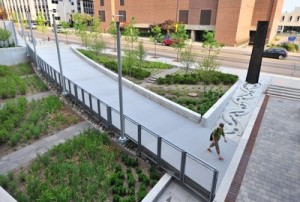
HRWC gathers county governments to forge ahead with innovative stormwater solutions, compiles most helpful resources
This past summer has seen some major milestones in our project on green infrastructure (GI). For nearly two years we have been clarifying the way forward for Washtenaw County with regard to the implementation of green infrastructure stormwater features — rain gardens, bioswales, green roofs, pervious pavement, etc. We worked with agencies and organizations throughout the county to identify the barriers to green infrastructure, strategies for overcoming those barriers, and tools and resources for taking the next steps.
Three “Growing Green Infrastructure Forums” were held this summer on the topics of overcoming the barriers, funding green infrastructure, and operation and maintenance of green infrastructure features. Attendees ranged from state to local entities: Michigan Department of Environmental Quality, Washtenaw County Water Resource Commissioner and Road Commission, the City of Ann Arbor, the Village of Dexter, Pittsfield Township and other municipalities were involved. Stormwater directors from both Grand Rapids and Toledo talked to participants about their GI programs. Three local consultants with green infrastructure experience offered insight and assistance on topics small and large.
Throughout the forums, HRWC researched and highlighted a dozen of the most current and useful resources available online, such as Portland, Oregon’s Field Guide to Maintaining Rain Gardens, Swales, and Stormwater Planters. These resources have now been gathered together on our new Green Infrastructure Resources page under three categories: economics and funding, policies and permitting, and operations and maintenance. Each resource is presented with a description of the key findings or tools found within the resource and a link for easy access. The pages are intended for state or local policymakers, members of city councils or planning boards, municipal staff (including practical manuals and checklists for maintenance departments), developers, and even homeowners.
This green infrastructure project is wrapping up this fall with the release of additional locally-relevant tools and a major alternative proposal for a redevelopment project in Washtenaw County. However, this experience has firmly rooted HRWC’s belief that treating and infiltrating water on-site as the default stormwater management practice is an important step toward protecting the economic and environmental vitality of Washtenaw County and the broader watershed.



